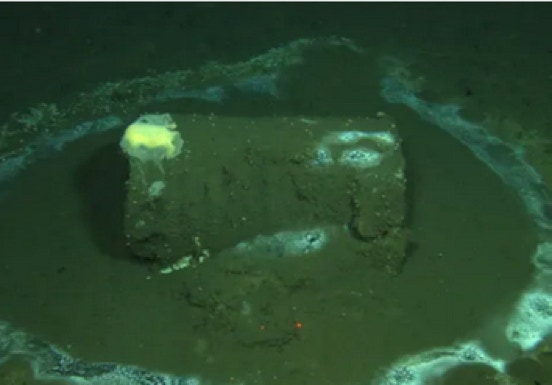Catalina Island’s Silent Spring
Did you ever read Rachel Carson’s book Silent Spring? It’s the horror story of rampant DDT poisoning of the environment.
It’s happened again, this time at the bottom of the sea, eight miles off Catalina Island. As the barrels rust through, they release their DDT, poisoning the sea and the humans and sea life that swims in the water. What will happen to property values on Catalina Island when it is made known that the sea is heavily laced with DDT is anybody’s guess.
The headline read:
[Tens of] thousands of barrels of DDT
found dumped in the ocean
near Catalina Island
off the coast of California
Associated Press
Tue 27 Apr 2021 05.44 EDT
Marine scientists say they have found what they believe to be more than 27,000 barrels containing DDT dumped off the southern California coast near Catalina Island, where a massive underwater toxic waste site dating back to the second world war has long been suspected.
The 27,345 “barrel-like” images were captured by researchers at the University of California San Diego’s Scripps Institution of Oceanography. They mapped more than 36,000 acres of seafloor between Santa Catalina Island and the Los Angeles coast in a region previously found to contain high levels of the toxic chemical in sediments and in the ecosystem.
Historical shipping logs show that industrial companies in southern California used the basin as a dumping ground until 1972, when the Marine Protection, Research and Sanctuaries Act, also known as the Ocean Dumping Act, was enacted.
Resting deep in the ocean, the exact location and extent of the dumping was not known until now.
The territory covered was “staggering,” said Eric Terrill, chief scientist of the expedition and director of the Marine Physical Laboratory at Scripps Institution of Oceanography.
Underwater drones using sonar technology captured high-resolution images of barrels resting 3,000 ft. below the surface all along the seafloor that was surveyed. Barrels were also seen beyond the dumpsite limits.
“It really was a surprise to everybody who’s worked with the data and who sailed at sea,” he told reporters on Monday.
The survey provides “a wide-area map” of the barrels, though it would be up to others to confirm through sediment sampling that the containers held DDT, Terrill said. It is estimated between 320 and 640 tons of DDT were dumped in the area, 12 miles from Los Angeles, and 8 miles from Catalina Island.
The long-term impact on marine life and humans was still unknown, said Scripps chemical oceanographer and professor of geosciences Lihini Aluwihare, who in 2015 co-authored a study that found high amounts of DDT and other man-made chemicals in the blubber of bottlenose dolphins that died of natural causes.
“These results also raise questions about the continued exposure and potential impacts on marine mammal health, especially in light of how DDT has been shown to have multi-generational impacts in humans,” said Aluwihare, who was not part of the survey expedition.
Diana Aga, a chemistry professor at University at Buffalo who is not affiliated with the study, said the findings were shocking if the barrels were proven to contain the toxic chemical. “That’s a lot of DDT at the bottom of the ocean,” she said.
If the barrels had not leaked, they could be moved to a place where disposal was safer, Aga said. If the barrels have leaked, scientists could take samples from the water, sediment and other marine life to gauge the extent of the damage that has been done and is still being done.
Researchers on the research vessel Sally Ride deploy an autonomous underwater vehicle near Santa Catalina Island. Scientists conducted the survey from 10-24 March following a Los Angeles Times report last year about evidence that DDT was dumped into the ocean.
Terrill said: “Unfortunately, the basin offshore Los Angeles had been a dumping ground for industrial waste for several decades, beginning in the 1930s. We found an extensive debris field in the wide area survey.”
Scientists started the search where University of California Santa Barbara professor David Valentine had discovered concentrated accumulations of DDT in the sediments and spotted 60 barrels about a decade ago.
High levels of DDT have been detected in the area’s marine mammals, and the chemical has been linked to cancer in sea lions.
Scripps researchers say they hope their survey will support clean-up efforts. The expedition on the Sally Ride research vessel included a team of 31 scientists, engineers, and crew conducting 24-hour operations and two autonomous underwater vehicles.
Here is the last paragraph of Rachel Carson’s amazing book.
The current vogue for poisons has failed utterly to take into account these most fundamental considerations. As crude a weapon as the cave man’s club, the chemical barrage has been hurled against the fabric of life—a fabric on the one hand delicate and destructible, on the other miraculously tough and resilient, and capable of striking back in unexpected ways. These extraordinary capacities of life have been ignored by the practitioners of chemical control who have brought to their task no “high-minded orientation,” no humility before the vast forces with which they tamper. The “control of nature” is a phrase conceived in arrogance, born of the Neanderthal age of biology and philosophy, when it was supposed that nature exists for the convenience of man. The concepts and practices of applied entomology for the most part date from that Stone Age of science. It is our alarming misfortune that so primitive a science has armed itself with the most modern and terrible weapons, and that in turning them against the insects it has also turned them against the Earth.
Rachel Louise Carson (May 27, 1907 – April 14, 1964)
From
https://biologicaldiversity.org/w/news/press-releases/lawsuit-launched-over-ddt-ocean-dumping-off-southern-california-2021-05-27/
we read
Lawsuit Launched Over DDT Ocean Dumping off Southern California
By
Kristin Carden, (510) 844-7100 x 327
kcarden@biologicaldiversity.org (science/wildlife contact)
Charlie Tebbutt, (541) 285-3717
charlie@tebbuttlaw.com (legal contact)
Montrose Chemical Corp. Dumped About 500,000 Barrels of Toxic Waste Near Santa Catalina Island
TORRANCE, Calif.— Following the recent discovery that up to 500,000 barrels of the banned pesticide DDT were dumped into the Pacific Ocean off Southern California, the Center for Biological Diversity sent Montrose Chemical Corp. and its successor parent company, Bayer Corp., a notice of intent to sue them today. Today’s notice letter calls for the companies to take responsibility for this toxic threat to public health and wildlife.
Starting in 1947 and continuing through at least 1961, Montrose employees transported barrels of DDT and acid sludge waste from the company’s Torrance, Calif. facility to barges, where they were dumped into the ocean near Santa Catalina Island. The massive ocean dumping site was discovered by scientists and publicized last year by award-winning articles in the Los Angeles Times.
“The nightmare legacy of DDT continues to rear its ugly head,” said attorney Charlie Tebbutt. “Since Rachel Carson’s Silent Spring, the world has known of DDT’s destructive impacts. It is time for the manufacturers and willing successors of this toxic stew to take responsibility for this travesty and clean up their mess. Our clients intend to make that happen.”
There is also a DDT dumping site off the Palos Verdes Peninsula, which is now a Superfund cleanup site. The subsequent discovery of even more DDT dumping farther offshore prompted today’s notice letter. The Center is represented by the Law Offices of Charles Tebbutt, PC.
“As a graduate student at UC Santa Barbara, I was shocked to learn about the legacy of DDT contamination in California’s coastal waters,” said Kristin Carden, an ocean scientist with the Center. “We need to better understand how this DDT is circulating through our coastal ecosystems so we can protect wildlife from further harm. The United States banned use of DDT in 1972 because it was so durable and harmful to brown pelicans and other species. Learning that it’s been leaking from dumped barrels into California’s coastal waters for decades after that is truly alarming.”
The notice letter states that Montrose and related entities are violating the federal Resource Conservation and Recovery Act. DDT, which stands for dichlorodiphenyltrichloroethane, is highly toxic and carcinogenic and linked to a wide variety of health problems in both humans and wildlife. It’s also very durable, and as decades of science has shown, DDT biomagnifies and bioaccumulates as it travels through food webs.
The Center for Biological Diversity is a national, nonprofit conservation organization with more than 1.7 million members and online activists dedicated to the protection of endangered species and wild places.
###

